1. The Momentum Equation And Its Applications
We have all seen moving fluids exerting forces. The lift force on an aircraft is exerted by the air moving over the wing. A jet of water from a hose exerts a force on whatever it hits. In fluid mechanics the analysis of motion is performed in the same way as in solid mechanics - by use of Newton's laws of motion. Account is also taken for the special properties of fluids when in motion.
The momentum equation is a statement of Newton's Second Law and relates the sum of the forces acting on an element of fluid to its acceleration or rate of change of momentum. You will probably recognise the equation F = ma which is used in the analysis of solid mechanics to relate applied force to acceleration. In fluid mechanics it is not clear what mass of moving fluid we should use so we use a different form of the equation.
Newton's 2nd Law can be written:
The Rate of change of momentum of a body is equal to the resultant force acting on the body, and takes place in the direction of the force.
To determine the rate of change of momentum for a fluid we will consider a streamtube as we did for the Bernoulli equation,
We start by assuming that we have steady flow which is non-uniform flowing in a stream tube.
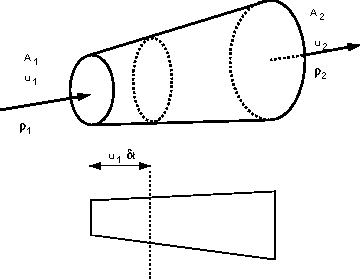
A streamtube in three and two-dimensions
In time  a volume of the fluid moves from
the inlet a distance
a volume of the fluid moves from
the inlet a distance  , so the volume entering
the streamtube in the time
, so the volume entering
the streamtube in the time  is
is

this has mass,

and momentum

Similarly, at the exit, we can obtain an expression for the momentum leaving the steamtube:

We can now calculate the force exerted by the fluid using Newton's 2nd Law. The force is equal to the rate of change of momentum. So

We know from continuity that  , and if
we have a fluid of constant density, i.e.
, and if
we have a fluid of constant density, i.e.  ,
then we can write
,
then we can write

For an alternative derivation of the same expression, as we know from conservation of mass in a stream tube that

we can write

The rate at which momentum leaves face 1 is

The rate at which momentum enters face 2 is

Thus the rate at which momentum changes across the stream tube is

i.e.

This force is acting in the direction of the flow of the fluid.
This analysis assumed that the inlet and outlet velocities were in the same direction - i.e. a one dimensional system. What happens when this is not the case?
Consider the two dimensional system in the figure below:
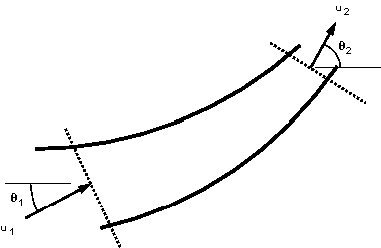
Two dimensional flow in a streamtube
At the inlet the velocity vector,  , makes
an angle,
, makes
an angle,  , with the x-axis, while at
the outlet
, with the x-axis, while at
the outlet  make an angle
make an angle  .
In this case we consider the forces by resolving in the directions
of the co-ordinate axes.
.
In this case we consider the forces by resolving in the directions
of the co-ordinate axes.
The force in the x-direction
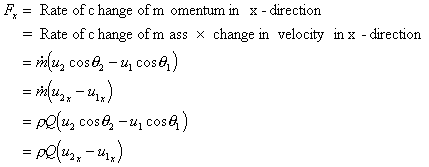
And the force in the y-direction
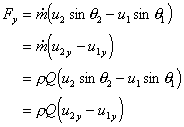
We then find the resultant force by combining these vectorially:
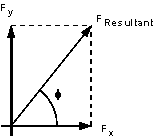

And the angle which this force acts at is given by

For a three-dimensional (x, y, z) system we then have an extra force to calculate and resolve in the z-direction. This is considered in exactly the same way.
In summary we can say:

Remember that we are working with vectors so F is in the direction of the velocity. This force is made up of three components:
 Force exerted on the fluid by any solid
body touching the control volume
Force exerted on the fluid by any solid
body touching the control volume
 Force exerted on the fluid body (e.g.
gravity)
Force exerted on the fluid body (e.g.
gravity)
 Force exerted on the fluid by fluid pressure
outside the control volume
Force exerted on the fluid by fluid pressure
outside the control volume
So we say that the total force, FT, is given by the sum of these forces:

The force exerted by the fluid on
the solid body touching the control volume is opposite to  .
So the reaction force, R, is given by
.
So the reaction force, R, is given by

